mobile View, to the German Version tap the flag
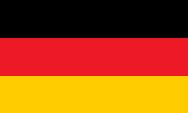

- Republic of Iceland
- parliamentarian republic
- own name: Lýdveldid Ísland
• Flags
• Historical Flags
• Meaning/Origin of the Flag
• Coat of Arms
• Meaning/Origin of the Coat of Arms
• Map
• Numbers and Facts
• History
• Origin of the Country's Name
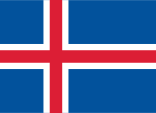
National and merchant flag,
ratio = 18:25,
Source, by: Flaggen und Wappen, Corel Draw 4





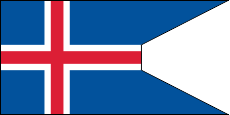
State flag and flag of the coast guard,
ratio = 18:36 (1:2),
Source, by: Flaggen und Wappen, Corel Draw 4



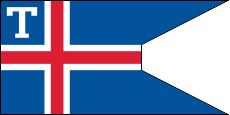
Customs flag,
ratio = 18:36 (1:2),
Source, by: Die Welt im bunten Flaggenbild



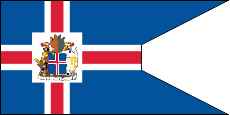
Flag of the President,
ratio = 18:36 (1:2),
Source, by: Flaggen und Wappen, Corel Draw 4



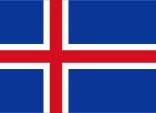
colour proposal in pt 287 and pt 1795,
Source, by:
Wikipedia (DE)




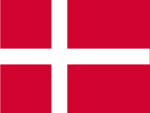
1380–1918,
Iceland was until 1918 a component of Denmark and solely it's flag was used,
Source, by:
Flags of the World





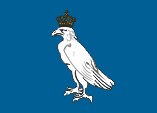
1921–1943,
Flag of the King,
ratio = 18:25,
Source, by:
Flags of the World



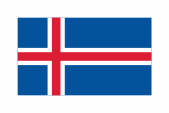
Pilot jack,
ratio = 2:3,
Source, by:
Die Welt im bunten Flaggenbild
This type of flag was abolished in the 20th century, today is:
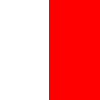 Pilot on board
Pilot on board
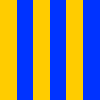 Call for Pilot
Call for Pilot




The flag of Iceland is blue with a white-bordered red scandinavian cross. Blue and white (silver) are the historical Icleandic colours. The scandinavian cross should point at the affiliation to the nordic people's family. The red in the scandinavian cross should remember the historical connexions to Denmark. The in inversion of the colours existing similarity to the Norwegian flag is in this way probably sheer accidental, although there are allegations that in this way should be pointed out at the initially affiliation of Iceland to Norway and the colonization from there. The colors are interpreted as follows: Blue stands for the sea, white for ice and snow, red for the volcanoes. Following the colour system "Dictionnaire International de la Couleur" (DIC, SCOTDIC), the colours of Iceland were defined in 1991 as heaven blue: SCOTDIC 693009 and fire red: DIC ICELAND FLAG RED. As the blue was not defined before, in practice any blue was often used, more often dark. The many different and also dark shades of blue reproduced in books and catalogues show this clearly. Presumably, this was and is due to the peculiar DIC colour system. There are considerations to redefine the colours in the better known Pantone colour system (PMS), namely blue = pt 287 and red = pt 1795, which would mean slight changes in colouring. This is probably why the project will not be pursued for the time being. So long as Iceland belonged to Denmark (to 1919) has to be used the Danish flag. In the year 1903 Iceland got awarded a new coat of arms in the colours white and blue (white/silver hawk on blue), and they started to use unofficialy flags in diverse variants from this both colours mostly with the scandinavian cross, just as a scutcheon flag with the heraldry of the coat of arms, which showed the crowned silvery hawk on a blue bunting. In the year 1913 the current flag was designed and adopted by the parliament on 22nd of November in 1913. From the 19th of June in 1915 it was allowed to use it on land as soon as on vessels in territorial waters. On 1st of December in 1918, the day of the independence from Denmark, the flag could be shown on the high seas. However, it was not until the year 1919 officially recognized by the Danish King Christian X. As the republic was proclaimed on the 17th of June in 1944 this flag was assumed as state's flag. From 1918 Iceland remained associated with Denmark in personal union. This meant that the king of Denmark was also the King of Iceland. In the year 1921 the king received his own flag. It showed the image of the old coat of arms, a crowned white hawk on blue.
Source:
Flags of the World,
Die Welt der Flaggen,
Flaggen Wappen Hymnen,
Flaggen und Coat of arms of the Welt,
Wikipedia (DE)


13th –14th century,
Coat of arms of Iceland,
Source, by:
sguardosulmedioevo.org

14th cent. to 1903,
Coat of arms of Iceland,
Source, by:
Flags of the World
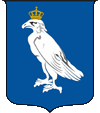
1903–1919,
Coat of arms of Iceland,
Source, by:
Flags of the World,
Thanks to Roland Daebel
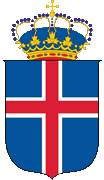
1919–1944,
Escutcheon (shield) of Iceland,
Source, by:
Flags of the World

since 1944,
Escutcheon (shield) of Iceland,
Source, by:
Flags of the World
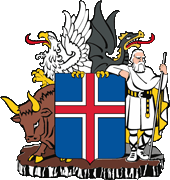
since 1944,
Greater coat of arms of Iceland,
Source, by:
Flaggen und Wappen, Corel Draw 4

From the Norwegian times of the island is known a twelvefold striped scutcheon in white and blue. Under the Danish was introduced a red blazon which showed a silvery codfish below a crown. On the 3rd of October in 1903 was introduced a new coat of arms. It showed a silvery hawk on a blue shield. Therewith were reproduced again the historical colours of Iceland within a coat of arms. The today's greater coat of arms of the state was adoped at the 12th of February in 1919 by royal decision and changed in that on 17th of June in 1944 that the crown was removed, the shield holders were changed a little bit and arranged slightly different and as a bracket was deployed a rock plate. It stands for Iceland and it's craggy coast. The four shield holders (bull, warrior, dragon and griffin) are the legendary protectors of Iceland, how described in the "Heimskringla Saga".
Source:
Flags of the World,
Die Welt der Flaggen,
Flaggen Wappen Hymnen,
Flaggen und Coat of arms of the Welt

Location:
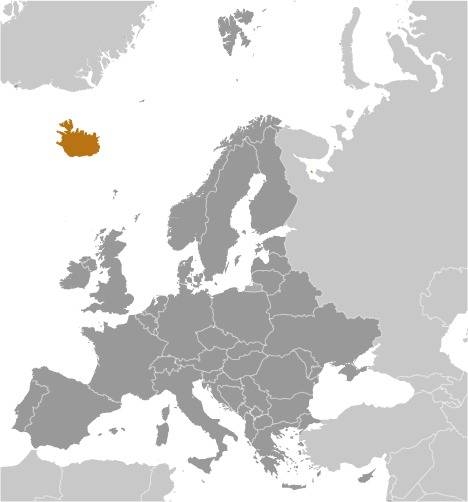
Source: CIA World Factbook
Map of the country:
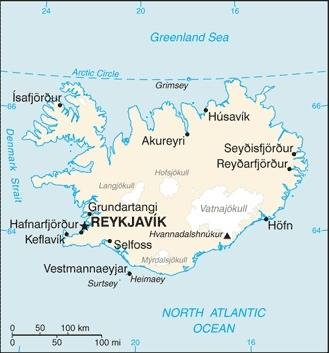
Source: CIA World Factbook

Area: 39.816 square miles
Inhabitants: 361.000 (2019), thereof 96,5% Icelanders, 0,5% Polish, 0,3% Danish
Religions: 70% Protestant, 4% Roman Catholic, 1% Asatru, 8% Non-Religious
Density of Population: 9 inh./sq.mi.
Capital: Reykjavík, 128.793 inh. (2019)
official Language: Icleandic
Currency: 1 Icleandic Crown (ISK, ikr) = 100 Aurar
Time Zone: GMT
Source:
Wikipedia (DE),
CIA World Factbook

ca. 750 · legendary initial settlement of Iceland by Celts and Irish monks
874 · beginning of the Norwegian settlement
930 · first Althing (national assembly)
ca. 1000 · beginning christianization, but the Germanic religion maintains until the present days
since ca. 1200 · growing economic dependence from Norway
1262 · Icleandic-Norwegian contract, Iceland subordinates itself the Norwegian crown
1294 · the king issues a trade interdiction against foreign countries
1380 · by the succession of a Danish successor on the vacant Norwegian throne become Iceland and Norway a Danish possession
1550 · reformation
1602 · the king issues a trade interdiction against foreign countries again, trade monopoly for Danish merchants
1800 · the Althing (national assembly) gets abolished
1843 · re-establishing of the Althing
1874 · Iceland gets a constitution, granting of internal autonomy
1st of December 1918 · Iceland gets a new constitution, becomes an independent kingdom obliged in personnel union with Denmark (Danish king = Icleandic king)
1940 · Denmark gets occupied by German troops, the Althing enlarges the authorities of the Icleandic government
10th of May 1940 · British troops occupy Iceland
7th of July 1941 · US-American troops occupy Iceland and begin to prepare military bases
23rd of December 1943 · Iceland terminates the personnel union with Denmark
17th of June 1944 · after successful plebiscite transformation of Iceland into a republic
1949 · founder member of NATO
1951 · contract with the USA, further maintaining of the US military bases
1958 · extension of the territorial waters on 12 nautical miles
1972 · extension of the fishery's borders on 50 nautical miles
1972 · the Germanic religion (Asatru) gets officially recognized again
1975 · extension of the fishery's borders on 200 nautical miles
2006 · the U.S. troops leave the country
2009 · application to join the European Union
2015 · withdrawal of the application to join the European Union
Source:
Atlas zur Geschichte,
World Statesmen,
Wikipedia (D),
Discovery '97,
Weltgeschichte

The existence of Iceland was probably already known in ancient times. The Greek Pytheas mentions a "Thule", and also the "Landnámabók" from the 11th century mentions this name and brings him in connection with the Irish monk Beda. But if the today's Iceland really was Thule is not known. The Viking Naddoddur reached the island around the year 860, but called it "Snæland" (snow land). A little later the Swede Garðar Svavarsson landed on the island and named her "Garðarsholmur" after himself. The Viking Flóki Vilgerðarson also landed on the island during those years. He called the island "Iceland", inspired by drift ice he saw in the north of the island.
Source:
Wikipedia (D)


![]()
































